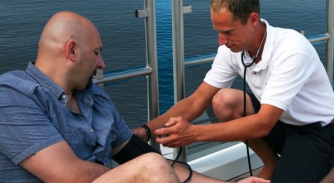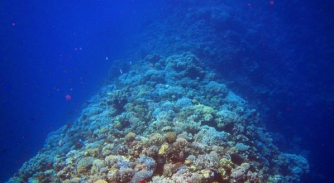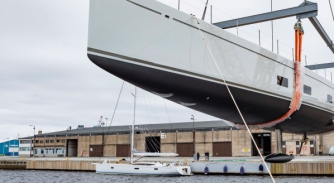The Nuclear Equation
Developments across the marine industry suggest the idea of a nuclear-powered superyacht may not be as science fiction as it once sounded…
In the quest for zero emissions, different corners of the marine sector are closing in on nuclear power as a possible solution. The question of its utility for superyachts is gathering cautious momentum. However, concepts like Earth 300, released in 2021, seem too far-fetched to work, right? I thought so when I first saw it, but should we doubt this level of ambition from the superyacht industry? Or underestimate the potential of nuclear power on private vessels?
Recent nuclear-powered concepts from the cruise and commercial sectors seem more grounded in the reality of effectively reaching emissions standards. Associations with classification societies and attainable-sounding technological barriers imply that this may be a plausible option for the next generation fleet. One technology, in particular, is gaining momentum across the marine industry: The Molten Salt Reactor (MSR)
The IMO is targeting a reduction in carbon emissions from international shipping of 40 per cent by 2030, in comparison to 2008 levels, in line with the UN Sustainable Development Goals. This will require drastic solutions. In 2010, Lloyd’s Register began formulating new rules for nuclear-powered ships, saying it had received some approaches for developing nuclear vessels from various interested parties. Likewise, RINA is associated with the Earth 300 concept.
The nuclear equation, when taken simplistically, seems clear. However, zero carbon emissions and decades-long operational timelines from a few kilograms of fuel, too many, sound too good to be true. Nuclear detractors are quick to highlight the shortcomings; the infamous incidents at Chornobyl in 1986, Three Mile Island in 1979 and Fukushima in 2011 have ensured that the mention of nuclear power has calamitous connotations.
Nuclear-powered vessels have a military association. The USA, Russia, UK, India, France and China all have extensive nuclear-powered fleets. The energy efficiency of nuclear-powered ships bears reiterating. Using the US Navy as an example and comparing two aircraft carriers of the same size lays this out starkly.
The 321 m USS John F. Kennedy, and the 332m USS Dwight D. Eisenhower were launched seven years apart. The former ran on heavy fuel oil and at full operational speeds while running the flight deck it had a fuel consumption rate of roughly 4.5 tonnes per ship length travelled. While the latter, on its nuclear propulsion and with a similar operational profile, consumed an amount of fissile fuel the size of grapefruit in 20 years.
The fear of meltdown and the significant issue of nuclear waste disposal looms large over these traditional reactors. However, it is also worth reiterating that, according to a feature that first appeared in Forbes in 2020, The Nuclear Navy worldwide has logged over 5,400 reactor years of accident-free operations and travelled over 130 million miles on nuclear energy, enough to circle the earth 3,500 times. The annual radiation levels Navy crews were exposed to was also calculated at one thousand times less than the acceptable limits for a hospital radiology department.
There may be another option, first developed nearly 60 years ago, that is seeing renewed attention from the marine industry. UK-Based Core Power is working with the Bill Gate affiliated Terrapower to develop a molten salt reactor (MSR) suitable for shipboard power production. MSRs present an intriguing possibility, and a quick physics lesson may be needed.
If you didn't know that a nuclear reactor heats water, creating steam and turning a turbine don't worry, I didn't until embarrassingly recently either. I would wager that many people's knowledge received a significant boost after the enthralling HBO series Chernobyl aired in 2020 also. Controlling this nuclear reaction safely, and making use of more accessible fuels are the key issues that MSRs theoretically address.
The use of pressurised helium or water to cool traditional fission nuclear reactors is one of the most dangerous aspects of their operations, and a significant contributor to the risk of an explosive meltdown. MSRs overcome this by using a reactive core of nuclear material and molten salt. Salt liquefies at around 400C, and the rupturing of the core would see a drop in temperature and the near-instant solidification of the core preventing a meltdown.
These reactors can also repurpose semi-spent fuels from other sources. There is a significant buzz about using thorium as a nuclear fuel to further boost the efficiency of MSRs. This naturally occurring element is three times more abundant than uranium in the earth's crust. Thorium itself will not split and release energy. When it is exposed to neutrons, it will undergo a series of nuclear reactions until it eventually emerges as an isotope of uranium called U-233, which will readily split and release energy the next time it absorbs a neutron. Thorium is therefore called fertile, whereas U-233 is called fissile.
Using dissolved thorium in MSRs seems like a promising prospect for the marine industry. I even received a press release recently that implied it may be the ‘silver bullet solution’ in the sector's quest for zero carbon. The expedition cruise concept ‘Thor”, and its twin “Sif” from Norwegian shipbuilder Ulstein, hope to combine these technologies.
"Sif produces no emissions, so she can cruise in full-electric mode, and Thor would be its charging station. They are concepts right now and they might not be built in this way, but they start important discussions. We've been thinking about thorium as an energy source since 2008, but there is a stigma associated with nuclear power," says Ulstein chief designer Øyvind Gjerde Kamsvåg.
"Although there are no thorium reactors up and running today it is a proven technology, with the earliest examples operating back in the 1950s and 1960s. However, that also means, unlike uranium, there’s currently no supply chain. But as thorium is around three times more abundant in the Earth’s crust than uranium – and there’s a lot here in Norway – it’s simply a matter of starting up the mining process. Every new energy source has to start somewhere. The barriers to utilising thorium are certainly not insurmountable,” Says Robert McDonald, Principal Engineer, Institute for Energy Technology (IFE).
Despite these benefits of the thorium MSR, it is worth noting that this is not a new technology. The US military conducted an extensive development program with hopes to use the MSR to power long-range bombers. During their lifecycle, these reactors operated only 40 per cent of the time, compared to the average commercial reactor at 90 per cent. From 1945 to 1969 it was shut down 225 times, of these, only 58 were planned.
One of the major limitations of an MRS is that the materials used to manufacture molten salt-reactor components must maintain their integrity in highly radioactive and corrosive environments at elevated temperatures. Currently, few alloys can survive these extremes.
Still, as well as the Terrapower/Core Power project, South Korean shipbuilder Samsung Heavy Industries (SHI) has partnered with Korea Atomic Energy Research Institute (KAERI) to develop MSR nuclear-powered vessels, with DNV exploring nuclear fission as a source of power.
The question of crewing these vessels is a daunting one. One of the contributing factors to the decommissioning of the first nuclear-powered commercial vessel, the USS Savannah, in the 1970s was the extreme wages needed to attract sufficiently qualified reactor engineers away from relatively more comfortable jobs overseeing land-based power stations.
A vessel without the need for constant bunkering, and with the significantly more efficient use of internal spaces without traditional fuel tanks has obvious benefits. A cruising range governed by provisions, waste and crew turnovers and not fuel is most definitely not limitless, however. As many expedition yachts will tell you, there is a long list of limiting factors beyond fuel that must be addressed. The imperfect history of the MSR should give the industry pause also. This would represent a technological jump beyond anything the superyacht industry has so far attempted and only addresses some of the many complex issues that surround the environmental impact of a superyacht.
The utopian dreams of nuclear power providing power supplies that are 'too cheap to charge for' have not eventuated as predicted a couple of generations ago. Safety concerns are one factor. The complexities of physics and public perception are others. In an industry still grappling with how to effectively and safely crew today's expanding fleet, and with alternative fuels further complicating the situation for Flag and Class, the nuclear equation may still be a step too far to meet the impending emissions targets.
Hopefully, the commercial sector and cruising industries can outline a safe and effective platform to build from, and some of these 'crazy concepts' that were written off as too outlandish could become a zero carbon reality for a few superyachts.
References:
https://www.rina.org.uk/TNA_Nuclear_powered_ships_are_they_worth_their_salt.html
https://whatisnuclear.com/thorium.html
https://thebulletin.org/2022/06/molten-salt-reactors-were-trouble-in-the-1960s-and-they-remain-trouble-today/
https://www.forbes.com/sites/jamesconca/2020/11/09/international-marine-shipping-industry-considers-nuclear-propulsion/?sh=5091b494562c
https://whatisnuclear.com/msr.html
https://www.iaea.org/topics/molten-salt-reactors
NEW: Sign up for SuperyachtNewsweek!
Get the latest weekly news, in-depth reports, intelligence, and strategic insights, delivered directly from The Superyacht Group's editors and market analysts.
Stay at the forefront of the superyacht industry with SuperyachtNewsweek
Click here to become part of The Superyacht Group community, and join us in our mission to make this industry accessible to all, and prosperous for the long-term. We are offering access to the superyacht industry’s most comprehensive and longstanding archive of business-critical information, as well as a comprehensive, real-time superyacht fleet database, for just £10 per month, because we are One Industry with One Mission. Sign up here.
Related news

Another week, another fire
Instead of searching for specific factors to blame, the time is right to reflect on safety across the industry
Opinion

MedAire publishes superyacht injury and illnesses findings
MedAire, an International SOS Company, has today revealed new data highlighting the most common injuries and illnesses onboard superyachts
Crew

What do you think of forward looking sonar systems?
The Superyacht Agency is researching the market's perception and application of forward looking sonar systems, and we welcome your feedback
Technology

Where is the anchor?
Ned Wood, technical sales director, at Manson Anchors, discusses the evolution of the submarine anchoring system
Technology
-016b.jpg)
Inmarsat to launch Fleet Safety
John Dodd, director of safety services at Inmarsat, hopes to change the way we think about GMDSS
Crew
Related news
Another week, another fire
3 years ago
Where is the anchor?
4 years ago
Inmarsat to launch Fleet Safety
4 years ago
NEW: Sign up for
SuperyachtNewsweek!
Get the latest weekly news, in-depth reports, intelligence, and strategic insights, delivered directly from The Superyacht Group's editors and market analysts.
Stay at the forefront of the superyacht industry with SuperyachtNewsweek



